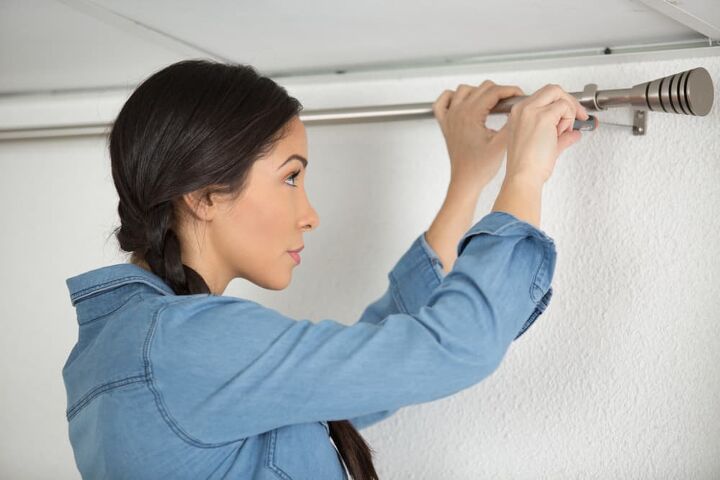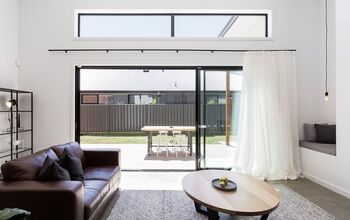Standard Curtain Rod Sizes (with Drawings)

Choosing the suitable fabric for curtains can be a challenge, but don’t forget to select the proper hardware. It’s just as important to choose the right curtain rod as it is to choose the right curtain. Use this guide to determine the size and type of curtain rod you need to fit best in your home.
Curtain rods come in four standard lengths. Standard curtain rods are 28 to 48 inches, 48 to 84 inches, 66 to 120 inches, and 120 to 170 inches. The average diameter for a curtain rod is 1 to 3 inches.
What Is the Average Size of a Curtain Rod?
Curtain rods are available in a variety of lengths, but there are four standard sizes you’ll find in stores. Standard curtain rods are 28 to 48 inches, 48 to 84 inches, 66 to 120 inches, and 120 to 170 inches.
While these options are appropriate for most common window sizes, sometimes it’s best to order adjustable rods. Adjustable rods can accommodate a broader range of window sizes. Ordering custom curtain rods is also an option if you have a unique window size.
Curtain rod diameters typically measure between 1 to 3 inches. However, the most common diameter of curtain rods is 1 ⅜ inch to 2 inches. These are typically for windows measuring between 66 to 120 inches.
28 to 48-Inch Curtain Rods
28 to 48-inch curtain rods are the smallest size rods for your smallest windows. These rods are best suited for kitchen curtains, bathroom windows, or partially glass doors you want to hang a curtain on.
For small windows like these, a curtain rod with a ⅝” diameter may be best to fit the space properly. However, keep in mind, if the fabric is heavier, the rod may bow. Therefore, if you have a heavier curtain material, choose a rod with at least a 1-inch diameter.
48 to 84 Inch Curtain Rods
A 48 to 84-inch curtain rod is for standard windows in your home. A standard, double-hung window is 24 to 48 inches. A 48 to 84inch rod is best for standard windows due to the extra inches needed during the rod installation.
66 to 120 Inch Curtain Rods
Any curtain rod longer than 60 inches is considered an extra-long rod. Due to the extra length, you should consider additional support brackets when installing 66 to 120-inch curtain rods.
Depending on the type of curtain, you will likely want a diameter rod of at least one inch. However, a larger diameter would work better, adding more support for multiple drapery panels. Plus, the wider diameter makes the rod look less flimsy as well.
You typically need 66 to 120-inch curtain rods when covering a group of windows, french doors, or patio doors.
120 to 170-Inch Curtain Rods
A 120 to 170-inch curtain rod is the largest standard-size curtain rod. You definitely want to use extra support to prevent sagging when you hang curtains.
The minimum diameter needed for this rod is 1 ⅛ inch. Although, again, a larger diameter will look and feel more substantial.
You can use a rod of this length to create fabric walls or cover large windows. Some 120 to 170-inch curtain rods come with up to six brackets for hanging and multiple rod pieces. These rod pieces will fit together to create the total length.
How Do I Measure for Curtain Rods?
Follow the steps below to measure for curtain rods.
Tools You Will Need:
- Measuring tape
- Pencil
- Level
Step 1: Measure Your Window
You have two options when measuring your windows. Depending on how far you want the rods to reach, you can measure the inner casing or outer frame. Regardless of which option you choose, stay consistent, so that window treatments are even throughout the space.
When measuring, record to the nearest 1/16 of an inch and always double-check your measurements. If you have multiple windows to measure, make sure to label them, so you don’t get them mixed up.
Step 2: Determine the Curtain Rod Length
Choosing the length of the curtain rod is up to you. However, there are two ways to determine the best curtain rod length. You can either add 20 percent to your window measurements or add six inches to both sides of the window.
Adding 20 percent or six inches on each side ensures that when your curtains are open, they won’t engulf the window. When your curtains are open, also known as stack back, they should cover about ⅓ of the window.
Step 3: Mark Your Wall
Use a pencil to make a small mark on the wall where you plan to place the curtain rod. Make sure you have a level handy so that you can hang your curtains as accurately as possible.
Step 4: Choose the Right Curtain Rod
After you have determined the correct measurements, you can select your curtain rod. Remember to account for curtain fabric as well as the ideal length for certain curtain fabrics. For example, some materials look better floating above the floor, while other materials look better puddled on the floor.
How to Measure for Curtain Rod Brackets
When selecting your curtain brackets, determine the appropriate clearance, return, and projection.
Clearance
Clearance is the free space between the back of the curtain and the wall or window. You measure clearance from the back of the curtain rod to the wall or window.
Return
Return is the point where the curtain will hang once it’s on the rod. This is the number of inches from the curtain to the wall. You measure it from the center of the curtain bracket cup to the wall.
Projection
Projection is the measurement of the full extension of the curtain rod bracket from the mounting plate to the point. You measure it from the front of the bracket back to the wall.
Two Ways to Mount Your Curtain Rod
Generally, hanging curtain rods on the wall above and outside of the window molding looks best. However, you can also choose to hang the rod above the window or outside the window, instead of both. If you have detailed window molding you don’t want to cover, an inside mount can work as well.
The following are the two main ways you can mount your curtain rods to maximize your windows.
1. Hanging the Rod Above the Frame
To create the illusion of a taller window, mount the curtain rod 4 to 6 inches above the window frame. You can also mount the rod halfway between the frame and the ceiling molding. If you choose that direction, don’t go more than 8 inches above the frame.
2. Hanging the Rod Wider Than the Frame
Hanging a curtain rod 3 to 6 inches wider than the frame on each side can make the windows feel larger. It also allows extra light when the curtains are open because the fabric won’t hang in front of the glass. If you want to display the window molding, you can leave 12 inches on either side of the window.
If you choose to display the molding, make sure to adjust your curtain rod measurements accordingly. Some people even hang curtains across the entire length of a wall.
This is an especially effective design trick when you want to center a large furniture item on a wall with an off-centered window. For example, it works if you need to center a bed on the wall, but the window is awkwardly placed. Hanging curtains across the entire wall can keep your design balanced.
Proper Curtain Rod Positioning
Whether you choose to hang your curtain rod above the window frame or wider than the window frame is ultimately a matter of personal preference. However, one thing remains true: the proper placement of curtain rods is centered on the windows. You want to allow for space on either side of the windows so that the curtains can rest against the wall when they’re opened and do not block the window.
Generally, this adds between three and six inches on either side, but the measurement can vary depending on your individual taste, the space you have to work with, and the curtains themselves.
Ways to Mount Your Curtain Rod Based on The Window
Different types of windows require different methods of mounting your curtain rod.
Here are the best practices for mounting curtain rods on square windows, transom windows, arched windows, and bay windows.
Square Window
For square windows, mount the curtain rod 3 inches below the ceiling or from the base of the crown molding. Add 12 inches to each side of the window to prevent your curtains from blocking light.
Transom Window
For transom windows, mount the curtain rod 3 inches below the ceiling. If that’s not possible, install the curtain rod between the upper and lower windows. If you use a heavier fabric, add ¼ to ½ inch of spacing as the fabric will stretch over time.
Arched Window
For arched windows, it looks best not to install window treatments at all. If you have to install curtains, hang the rod as high and far as possible from the top of the arch.
Bay Window
For bay windows, mount the curtain rod 3 inches below the ceiling. Choose hardware that has a corner bracket so you can have a single, connected rod.
How to Mount Hang Extra Long Curtain Rods
The larger the window, the coverage and support that you need. For curtain rods that extend beyond 60 inches, or five feet, a third bracket should be installed in the center of the window. This will prevent the curtain rod from sagging in the middle.
The bracket should be specifically placed in the center to allow you to close the curtains properly. To hang extra-long curtain rods, follow these steps:
- Start by measuring the length of your window. Then, add about six inches on either side to account for the end brackets.
- Using the number you obtained in step one (the length of the window plus 12 inches), divide by two to find the exact positioning of the center bracket.
- Determine how far above the window you want to install the brackets and then mark the spots accordingly.
- Use a level to verify that the marks are level.
- Drill holes for the anchors in install them using a rubber mallet.
- Screw the brackets into the anchors and position the curtain rod and curtains accordingly!
Related Questions
Do curtain rods have to be hung on studs?
While hanging curtain rods on studs is always ideal, there may not be studs available to hang the curtain rod correctly in relation to your window. Though, even if your wall may be able to hold a curtain rod and curtains, the constant opening and closing of the curtains can eventually pull the rod loose from the wall.In this case, wall anchors are highly advised. Wall anchors will grip the drywall, yielding a sturdy support system for hanging heavy objects.
How long should curtains be?
When determining how long your curtains should be, first consider the length and width of the fabric. You should hang drapes ½ inch off the floor so that they don’t collect dust. This also draws the eye up, which makes the room feel bigger. If you have heavier fabrics, add another ¼ inch to ½ inch of spacing, as these curtains will stretch over time. If you have uneven floors, curtains that extend onto the floor a few inches are more forgiving.
How wide should curtains be?
When it comes to curtain width, you want the curtains to look full when closed. Therefore, don’t simply purchase curtains the same width as your window. The width of the fabric should be one and a half to two times wider than the area you’re covering. If you want a more gathered, fuller look, you’ll need even more width. You can create a lavish, plush window treatment with lots of gathering by using multiple curtain panels. To determine how many curtain panels you need, divide the total width of the window by the width of the panel. Multiply the window width by two and a half to three if you want tightly gathered, full curtains. Divide this total by the width of a single curtain panel to get the number of panels you need.

Stacy Randall is a wife, mother, and freelance writer from NOLA that has always had a love for DIY projects, home organization, and making spaces beautiful. Together with her husband, she has been spending the last several years lovingly renovating her grandparent's former home, making it their own and learning a lot about life along the way.
More by Stacy Randall































